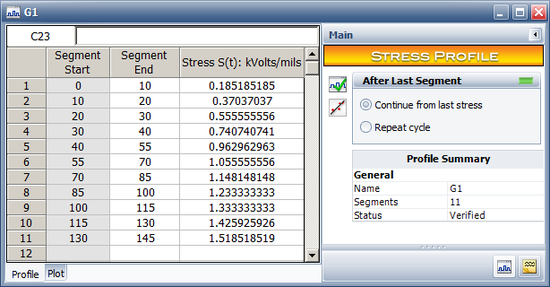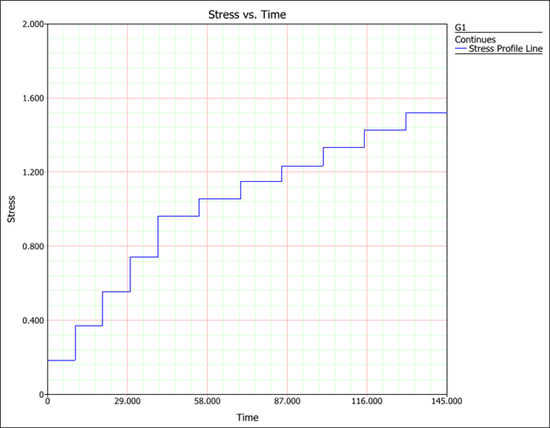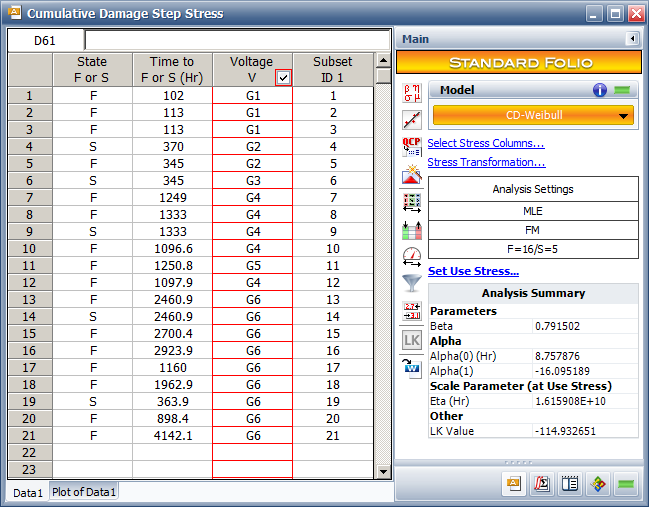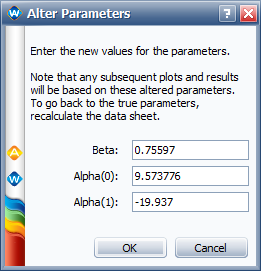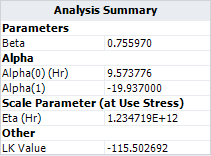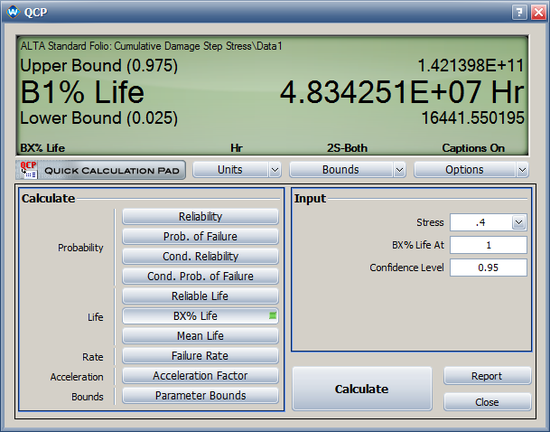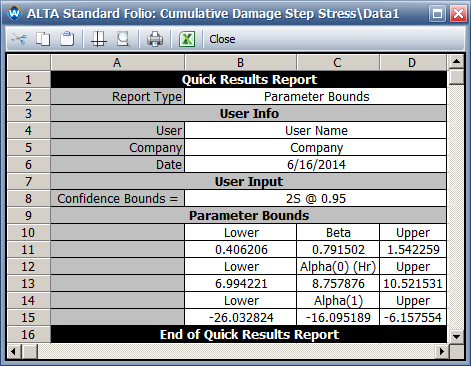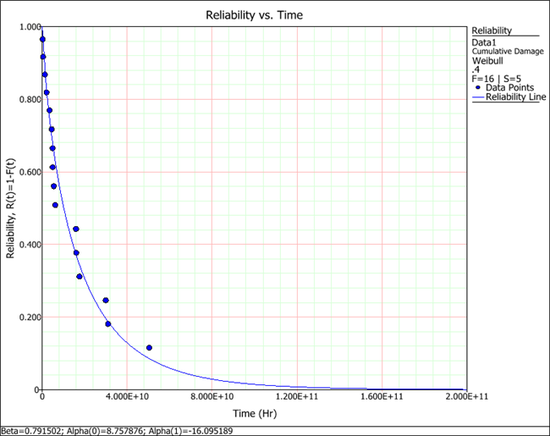Cumulative Damage Model for Step Stress Profiles
New format available! This reference is now available in a new format that offers faster page load, improved display for calculations and images and more targeted search.
As of January 2024, this Reliawiki page will not continue to be updated. Please update all links and bookmarks to the latest references at ALTA examples and ALTA reference examples.
|
Cumulative Damage Model for Step Stress Profiles |
This example validates the results for a cumulative damage model for a step stress test in an ALTA standard folio.
Reference Case
The data set is from Table 2.1 on page 496 in the book Accelerated Testing: Statistical Models, Test Plans, and Data Analysis by Dr. Nelson, John Wiley & Sons, 1990.
Data
A step-stress test is conducted for one type of cable insulation to estimate the insulation life at a constant design stress of 400 volts/mil. The test cables are of different thickness, in units of mils (0.001 inch). The stress is the applied step voltage divided by the thickness.
A total of 6 step-stress profiles are used. These stress profiles are calculated based on the applied voltage (Kilovolts) and the insulation thickness given on page 495 and Table 2.1. For all the stress profiles, the holding time for the first 4 steps is 10 mins. From step 5 onwards, a different a holding time is applied at each step for each of the stress profiles. These profiles are given in the following tables.
Profile 1 (named "G1"): The holding time after step 4 is 15 mins and the thickness is 27 mils.
| Segment Start Time | Segment End Time | Stress (Kvolts/mils) |
|---|---|---|
| 0 | 10 | 0.185185185 |
| 10 | 20 | 0.37037037 |
| 20 | 30 | 0.555555556 |
| 30 | 40 | 0.740740741 |
| 40 | 55 | 0.962962963 |
| 55 | 70 | 1.055555556 |
| 70 | 85 | 1.148148148 |
| 85 | 100 | 1.233333333 |
| 100 | 115 | 1.333333333 |
| 115 | 130 | 1.425925926 |
| 130 | 145 | 1.518518519 |
Profile 2 (named "G2"): The holding time after step 4 is 60 mins and the thickness is 29.5 mils.
| Segment Start Time | Segment End Time | Stress (Kvolts/mils) |
|---|---|---|
| 0 | 10 | 0.169491525 |
| 10 | 20 | 0.338983051 |
| 20 | 30 | 0.508474576 |
| 30 | 40 | 0.677966102 |
| 40 | 100 | 0.881355932 |
| 100 | 160 | 0.966101695 |
| 160 | 220 | 1.050847458 |
| 220 | 280 | 1.128813559 |
| 280 | 340 | 1.220338983 |
| 340 | 400 | 1.305084746 |
| 400 | 460 | 1.389830508 |
Profile 3 (named "G3"): The holding time after step 4 is 60 mins and the thickness is 28 mils.
| Segment Start Time | Segment End Time | Stress (Kvolts/mils) |
|---|---|---|
| 0 | 10 | 0.178571429 |
| 10 | 20 | 0.357142857 |
| 20 | 30 | 0.535714286 |
| 30 | 40 | 0.714285714 |
| 40 | 100 | 0.928571429 |
| 100 | 160 | 1.017857143 |
| 160 | 220 | 1.107142857 |
| 220 | 280 | 1.189285714 |
| 280 | 340 | 1.285714286 |
| 340 | 400 | 1.375 |
| 400 | 460 | 1.464285714 |
Profile 4 (named "G4"): The holding time after step 4 is 240 mins and the thickness is 29 mils.
| Segment Start Time | Segment End Time | Stress (Kvolts/mils) |
|---|---|---|
| 0 | 10 | 0.172413793 |
| 10 | 20 | 0.344827586 |
| 20 | 30 | 0.517241379 |
| 30 | 40 | 0.689655172 |
| 40 | 280 | 0.896551724 |
| 280 | 520 | 0.982758621 |
| 520 | 760 | 1.068965517 |
| 760 | 1000 | 1.148275862 |
| 1000 | 1240 | 1.24137931 |
| 1240 | 1480 | 1.327586207 |
| 1480 | 1720 | 1.413793103 |
Profile 5 (named "G5"): The holding time after step 4 is 240 mins and the thickness is 30 mils.
| Segment Start Time | Segment End Time | Stress (Kvolts/mils) |
|---|---|---|
| 0 | 10 | 0.166666667 |
| 10 | 20 | 0.333333333 |
| 20 | 30 | 0.5 |
| 30 | 40 | 0.666666667 |
| 40 | 280 | 0.866666667 |
| 280 | 520 | 0.95 |
| 520 | 760 | 1.033333333 |
| 760 | 1000 | 1.11 |
| 1000 | 1240 | 1.2 |
| 1240 | 1480 | 1.283333333 |
| 1480 | 1720 | 1.366666667 |
Profile 6 (named "G6"): The holding time after step 4 is 960 mins and the thickness is 30 mils.
| Segment Start Time | Segment End Time | Stress (Kvolts/mils) |
|---|---|---|
| 0 | 10 | 0.166666667 |
| 10 | 20 | 0.333333333 |
| 20 | 30 | 0.5 |
| 30 | 40 | 0.666666667 |
| 40 | 1000 | 0.866666667 |
| 1000 | 1960 | 0.95 |
| 1960 | 2920 | 1.033333333 |
| 2920 | 3880 | 1.11 |
| 3880 | 4840 | 1.2 |
| 4840 | 5800 | 1.283333333 |
| 5800 | 6760 | 1.366666667 |
The following table shows the test results.
| Status F/S | Time to F/S | Test Profile | Subset ID |
|---|---|---|---|
| F | 102 | G1 | 1 |
| F | 113 | G1 | 2 |
| F | 113 | G1 | 3 |
| S | 370 | G2 | 4 |
| F | 345 | G2 | 5 |
| S | 345 | G3 | 6 |
| F | 1249 | G4 | 7 |
| F | 1333 | G4 | 8 |
| S | 1333 | G4 | 9 |
| F | 1096.6 | G4 | 10 |
| F | 1250.8 | G5 | 11 |
| F | 1097.9 | G4 | 12 |
| F | 2460.9 | G6 | 13 |
| S | 2460.9 | G6 | 14 |
| F | 2700.4 | G6 | 15 |
| F | 2923.9 | G6 | 16 |
| F | 1160 | G6 | 17 |
| F | 1962.9 | G6 | 18 |
| S | 363.9 | G6 | 19 |
| F | 898.4 | G6 | 20 |
| F | 4142.1 | G6 | 21 |
Result
The power law life stress relationship and the Weibull distribution are used to analyze the data. At a constant stress V, the [math]\displaystyle{ \eta\,\! }[/math] is:
- [math]\displaystyle{ \eta(V) = \left(\frac{V_{0}}{V} \right)^p\,\! }[/math]
where [math]\displaystyle{ V_{0}\,\! }[/math] and [math]\displaystyle{ p\,\! }[/math] are the model parameters used in the book. The above equation can be rewritten as:
- [math]\displaystyle{ \eta(V) = e^{\alpha_{0}+\alpha_{1}ln(V)}\,\! }[/math]
where [math]\displaystyle{ \alpha_{0} = p \cdot ln(V_{0})\,\! }[/math] and [math]\displaystyle{ \alpha_{1} = -p\,\! }[/math]
The reliability function at time t and stress V is:
- [math]\displaystyle{ R(t,V) = e^{-\left(\frac{t}{\eta(V)} \right)^\beta}\,\! }[/math]
When stress is varying with time, the reliability at time t is given as:
- [math]\displaystyle{ R(t,V) = e^{-\left(\int_{0}^{t}\frac{1}{\eta(x)} dx\right)^{\beta}}\,\! }[/math]
In the book, the following results are provided:
- ML solution for the parameters are [math]\displaystyle{ \beta\,\! }[/math] = 0.75597, [math]\displaystyle{ V_{0}\,\! }[/math] = 1616.4 (1.6164 Kvolts), and [math]\displaystyle{ p\,\! }[/math] = 19.937.
- The maximum log likelihood is -103.53.
- The 1% percentile point (B1 life) at 0.4 Kvolts/mil is 2.81 x 109.
- The normal distribution approximation two-sided 95% confidence intervals are [math]\displaystyle{ \beta\,\! }[/math] = [0.18, 1.33], [math]\displaystyle{ V_{0}\,\! }[/math] = [1291, 1941.8], [math]\displaystyle{ p\,\! }[/math] = [6.2, 33.7], and the B1 life is [2.65 x 104, 2.98 x 1014].
Results in ALTA
First, we create each stress profile in ALTA. For example, the following picture shows the data for Profile G1.
The following picture shows the plot for this stress profile.
The next step is to enter the failure data into an ALTA standard folio and use the stress profiles to define the stress values, as shown next.
The log transformation is used for the stress. To compare the parameter values used in the book with the results obtained by ALTA, we need do convert the values in the book in terms of the parameters used in ALTA. Therefore the parameters in the book are: [math]\displaystyle{ \beta\,\! }[/math] = 0.75597, [math]\displaystyle{ \alpha_{0}\,\! }[/math] = 9.573776, [math]\displaystyle{ \alpha_{1}\,\! }[/math] = -19.937. Comparing these values to the value shown in the picture above, we see that the results obtained in ALTA are close to the results shown in the book.
The picture above also shows that the maximum log likelihood (LK Value) is -114.932651. This value is smaller than the value given in the book. To validate what the LK value would be if the results in the book were used in ALTA, we use the Alter Parameters tool, as shown next.
The resulting LK Value is -115.502692, as shown next.
This value is different from the value of -13.53 given in the book. Later, we will validate the calculations for this result.
Using the parameters values originally calculated in ALTA:
- The 1% percentile point (B1 life) at 0.4 Kvolts/mil is 4.8342 X 107 hours, as shown next. The value given in the book is 2.81 X 109. The results are different because of the differences in the values of the parameters of the model.
- The 2-sided 95% confidence intervals for the model parameters are shown next. These results are also different from the results in the book due to the estimated parameter values.
Validate the Likelihood Calculation in ALTA
For the ML solution given in the book, the parameters are: [math]\displaystyle{ \beta\,\! }[/math] = 0.75597, [math]\displaystyle{ \alpha_{0}\,\! }[/math] = 9.573776, [math]\displaystyle{ \alpha_{1}\,\! }[/math] = -19.937, and the log likelihood value is -103.53. Entering these parameters in ALTA, we get a log likelihood value of -115.502692. We will validate the calculation for the log likelihood value in ALTA to make sure it is correct.
Define the stress value at step i as [math]\displaystyle{ S_{i}\,\! }[/math]. If the test unit stayed in this stress level for a time period of [math]\displaystyle{ \Delta t_{i}\,\! }[/math], then the cumulative damage at this step will be [math]\displaystyle{ \frac{1}{\eta(S_{i})}\times \Delta t_{i}\,\! }[/math] and
- [math]\displaystyle{ A_{i} = \frac{1}{\eta(S_{i})} \times \Delta t_{i} = e^{-(\alpha_{0}+\alpha_{1}ln(S_{i}))} \times \Delta t_{i}\,\! }[/math]
For example, for the first failure, the failure occurred at 102, which is at the 9th step of profile G1. The test unit accumulates damage from each step stress it experienced before it fails. The first step stress value is 0.185185, which is the voltage divided by the thickness (5 Kvolts/27 mils). The length of the first step is 10 mins. Therefore, the damage at the 1st step segment is:
- [math]\displaystyle{ A_{1} = e^{-(\alpha_{0}+\alpha_{1}ln(S_{1}))} \times \Delta t_{i} = e^{-(8.757876+16.095189 \times 1.6864)}\times 10 = 2.56 \times 10^{-15}\,\! }[/math]
We can use this method to calculate the damage at each stress segment. The total damage will be the sum of the damage at each segment. For the first failure at time 102 under stress profile G1, the damage at each stress segment is calculated, as given below.
| Step | Profile G1 | Segment End | Voltage | Thickness | Stress | ln(S) | Cum Damage |
|---|---|---|---|---|---|---|---|
| 1 | 0 | 10 | 5 | 27 | 0.185185 | -1.68639895 | 2.50025E-15 |
| 2 | 10 | 20 | 10 | 27 | 0.37037 | -0.99325177 | 1.76011E-10 |
| 3 | 20 | 30 | 15 | 27 | 0.555556 | -0.58778666 | 1.20553E-07 |
| 4 | 30 | 40 | 20 | 27 | 0.740741 | -0.30010459 | 1.23907E-05 |
| 5 | 40 | 55 | 26 | 27 | 0.962963 | -0.03774033 | 0.0012707 |
| 6 | 55 | 70 | 28.5 | 27 | 1.055556 | 0.054067221 | 0.005573181 |
| 7 | 70 | 85 | 31 | 27 | 1.148148 | 0.138150338 | 0.021584512 |
| 8 | 85 | 100 | 33.4 | 27 | 1.233333 | 0.209720531 | 0.071720247 |
| 9 | 100 | 102 | 36 | 27 | 1.333333 | 0.287682072 | 0.031977014 |
| A = | 0.132138165 | ||||||
The total cumulative damage at a failure time of 102 is A in the above table.
Since the reliability function is:
- [math]\displaystyle{ R(t) = e^{-\left[\int^{t}_{0}e^{-(\alpha_{0}+\alpha_{1}ln(S(x)))} dx \right]^{\beta}} = e^{-A^{\beta}}\,\! }[/math]
The probability density function (pdf) at time t is:
- [math]\displaystyle{ \begin{align} f(t) =& R(t) \cdot \beta \cdot \left[\int^{t}_{0}e^{-(\alpha_{0}+\alpha_{1}ln(S(x)))} dx \right]^{\beta-1}\cdot e^{-(\alpha_{0}+\alpha_{1}ln(S(t)))} \\ =& e^{-A^{\beta}}\cdot \beta \cdot A^{\beta-1}\cdot e^{-(\alpha_{0}+\alpha_{1}ln(S(t)))} \\ \end{align}\,\! }[/math]
If an observation is a failure, then the pdf will be used to calculate its log likelihood value. If an observation is a suspension, then the reliability will be used to calculate its log likelihood value.
Since the 1st observation is a failure, the pdf is used. Using the model parameters and the cumulative damage A, the value of the pdf is:
- [math]\displaystyle{ \begin{align} f(t) =& e^{-A^{\beta}} \cdot \beta \cdot A^{\beta - 1} \cdot e^{-(\alpha_{0}+\alpha_{1}ln(S(t)))} \\ =& e^{-0.13214^{0.7906}} \times 0.7906 \times 0.13214^{0.7906-1} \times e^{-(8.7685 - 16.103 \times 0.2877)} \\ =& 0.016 \end{align}\,\! }[/math]
Take the logarithm of the above value and we get the log likelihood value for the first observation as [math]\displaystyle{ log(0.016) = -4.1489\,\! }[/math].
Repeating the above procedure, we can get the log likelihood value for each observation, as given in the following table.
| Status F/S | Time To F/S | Profile | Log likelihood Value |
|---|---|---|---|
| F | 102 | G1 | -4.148929577 |
| F | 113 | G1 | -4.518387096 |
| F | 113 | G1 | -4.518387096 |
| S | 370 | G2 | -0.72559186 |
| F | 345 | G2 | -4.983506849 |
| S | 345 | G3 | -0.910644661 |
| F | 1249 | G4 | -6.199936981 |
| F | 1333 | G4 | -7.129057207 |
| S | 1333 | G4 | -2.451259934 |
| F | 1096.6 | G4 | -6.518744419 |
| F | 1250.8 | G5 | -6.075214111 |
| F | 1097.9 | G4 | -6.523803805 |
| F | 2460.9 | G6 | -8.444820079 |
| S | 2460.9 | G6 | -0.29378846 |
| F | 2700.4 | G6 | -8.566484581 |
| F | 2923.9 | G6 | -7.469922325 |
| F | 1160 | G6 | -9.119207934 |
| F | 1962.9 | G6 | -8.086491838 |
| S | 363.9 | G6 | -0.015237126 |
| F | 898.4 | G6 | -10.4367511 |
| F | 4142.1 | G6 | -7.897236924 |
| Total | -115.033404 | ||
The log likelihood value calculated by hand in Microsoft Excel is -115.0334, as given in the above table. It matches the value in ALTA. The slight difference is caused by the precision error. Therefore, the log likelihood value calculated in ALTA is correct.
In fact, the optimization tool in Excel can also be used to find the ML solutions. Using the “Solver Add-in” program in Excel and the “GRG” nonlinear optimization, we get the same results in Excel as in ALTA.
The following reliability plot shows that the predicted values (the line) by the model can match the observed values (the points) very well.

